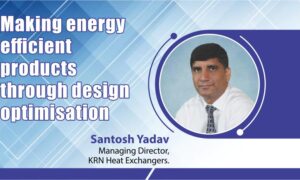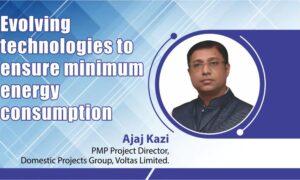In an interview with Thermal Control Business Update, Vikram Murthy, National President, ISHRAE, shares his opinions on how ISHRAE is playing a key role in the Indian HVAC&R industry and the how government initiatives are facilitating the industry’s growth.
What role does ISHRAE play in the Indian HVAC&R industry?
ISHRAE plays key roles in the HVAC&R industry.
ISHRAE implements standards and guides for equipment certification, climate design data, indoor environment quality, commissioning, refrigerant use, and many more. Some ISHRAE standards have been adopted as Indian Standards by the Bureau of Indian Standards (BIS), such as Chiller Test Standard, Climate Design Data, and more to follow.
ISHRAE publishes books and journals on a variety of subjects including design, methods and practice, which are distributed in India and overseas
ISHRAE does fundamental researches that validate current standards or lead to new ones carried out in premier labs and institutions across India.
We conduct certified courses in HVAC design, clean room, AC&R service, health care and more.
We also conduct exhibitions, seminars and conferences. These platforms run by ISHRAE across India give industry, government, institutions and professional an opportunity to display, discuss and develop good practices by consensus.
How do you see the National Clean Air Programme being implemented, when we still have many cities reeling under the effects of extreme pollution?
ISHRAE recommends minimum energy performance of all HVAC&R equipment and mandates zero ozone depletion as well as low GWP of all refrigerants used by manufacturers. These are based on ISHRAE standards and guidance. The National Clean Air Programme is a document directed at multiple stakeholders including industries, consumers and citizens apart from local governments. If each segment plays its role then clean air will be an achievable outcome as it is already happening in our neighbouring countries including China, Sri Lanka and Bangladesh. A determined national resolve by the people of India will work far better than any national programme can ever hope to achieve.
The India Cooling Action Plan seeks to train and certify 1,00,000 servicing sector technicians by 2022-23, synergising with the Skill India Mission. Would these actions have significant climate benefits?
The India Cooling Action Plan addresses several factors and key result areas. Skilling technicians are just one of them. The responsibility for skilling has to be the task of service provider companies, dealers, contractors and manufacturers assisted by training institutions and government ITIs across India. The certification of trained technicians will result in near-zero refrigerant leakage that will significantly reduce impact on climate change.
How, according to you, is India’s healthcare cold chain logistics shaping up? And, what is the current scenario of cold chain logistics in India?
National Cold Chain Development (NCCD), a Government of India department, closely monitors the development of the cold chain as well as provides guidance, training and incentives to the rapidly growing sector. However, the penetration of cold stores and consequently the cold chain is abysmal compared to developed countries, including our nearest neighbour — China.
The private sector must realise the large business opportunities of backward integration of cold stores and thereby rapidly raise the deployment of the India cold chain. Logistics suffers badly due to poor roads across India. Railway Wagon Cold Chain movement is also a driver that is underutilised. As is evident, the cold chain has a long path of growth towards developing food security as well as farmer economic benefit. For a healthy economy, this must become the prerogative of the private sector simply because it needs investment, management and the ability to reinvest profits. I see the beginning of such intent by several existing and potential investors.
How is refrigeration design essential for the overall functioning and efficiency of HVAC&R equipment?
Good refrigeration design must focus on just one aspect – energy, energy and energy. Once the objective of minimum energy becomes the key driver, then overall functioning, reliability and efficiency will be a natural corollary.
How essential is it to have safety equipment and gear while servicing HVAC equipment?
The aspect of safety must be an underlying principle for all servicing practice. Established manufacturers and their authorised dealers in India are trained throughout the year on Environment, Health & Safety (EH&S).
However, a large part of servicing is done by the unorganised sector, which gives safety a low or no priority. The fault lies with the consumers, including corporate consumers, who want to save in the short term, but loose out in the long term. Consumer education can change this as well as the licensing/certification and acceptance of HVAC technicians, just like electricians and plumbers.
What role could government play in boosting the growth of HVAC&R industry?
The government in India is probably the largest buyer of air-conditioning products and systems. The government has little else to do to boost the HVAC&R industry. It is a business whose growth is driven by market forces alone, just as it is around the world.
Demand for human comfort indoors is in direct proportion to the increase in prosperity of a growing urban populace. Growing industrial demand for process driven air-conditioning and refrigeration is a driver, too. If there is anything we need to do to meet our carbon reduction goals, it is to bring down demand for energy guzzling cooling systems.
Relentless driving of energy efficient design as well as finding solutions that use alternate methods of cooling shall lead us to be in harmony with nature.
What initiatives does ISHRAE have in store to revamp the industry in terms of energy efficiency?
ISHRAE’s key mission is to protect the environment. Energy efficiency forms the core of ISHRAE’s Standards and Guides as well as education programmes. ISHRAE continually interacts with the Bureau of Energy Efficiency to achieve its set mandates.
What, according to you, would the future of HVAC&R look like?
I speak of a future in a decade from now. The future of HVAC&R is adaptive cooling, natural cooling, thermal storage, radiant cooling, and passive cooling. The need to stop global warming has become critical for the planet. That driving force alone shall alter the HVAC&R industry completely. So, will man’s demand for overcooling his indoor environment reduce, just as man begins to adapt to the environment rather than trying to change it drastically? I refer to overcooling and overheating during summer and winter respectively. We were comfortable in our environments just a few decades ago.
The products of the HVAC&R industry as we now know them today will not exist 10 years from now. They will become dinosaurs whose time has nearly come. The inventions that will lead to HVAC&R products of the future are being tested in labs around the world.
I vision a cooler planet within a decade. ISHRAE shall play a significant role in that fulfilment.
A determined national resolve by the people of India will work far better than any national programme can ever hope to achieve
Vikram Murthy, National President, ISHRAE
Cookie Consent
We use cookies to personalize your experience. By continuing to visit this website you agree to our Terms & Conditions, Privacy Policy and Cookie Policy.















